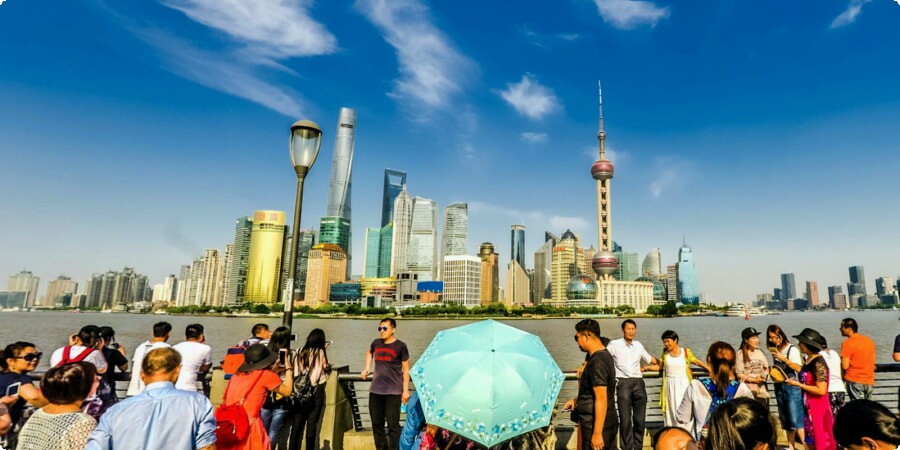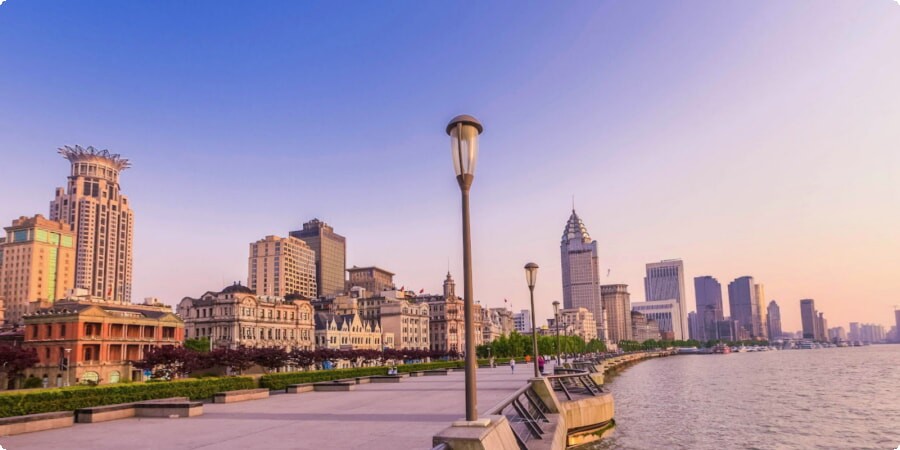Nestled along the western bank of the Huangpu River, The Bund stands as a testament to Shanghai's rich history and dazzling transformation. Known for its iconic skyline and historical architecture, this waterfront area has been a symbol of Shanghai’s status as a global metropolis since the late 19th century.
The Bund, or "Waitan" in Chinese, translates to "Outer Beach," a fitting name for this once marshy stretch that has evolved into one of Shanghai's most celebrated landmarks. It stretches approximately 1.5 kilometers from the Waibaidu Bridge to the southern end of the East Nanjing Road, offering panoramic views of the city's skyline, including the futuristic skyscrapers of Pudong across the river.
As Shanghai’s cultural and financial center, The Bund reflects the city's dynamic history, showcasing an array of colonial-era buildings that once housed banks, trading houses, and consulates. These grand structures, with their European architectural styles, contrast strikingly with the modern skyline of Pudong, representing a fascinating juxtaposition of old and new.
Discover The Bund on Google Maps and start your journey through Shanghai’s history and modernity.
A Walk Through The Bund: Key Attractions and Highlights
Strolling along The Bund offers a captivating journey through Shanghai's architectural evolution. Here are some of the key highlights that make this promenade a must-visit destination:
-
The Bund Historical Buildings: This stretch of The Bund is renowned for its impressive collection of early 20th-century buildings. Notable structures include:
- The Customs House: With its grand clock tower and British architectural style, this building served as the headquarters for the Shanghai Customs House and is an iconic symbol of The Bund’s colonial past.
- The HSBC Building: Once one of the largest and most opulent bank headquarters in the world, this Beaux-Arts style building now houses the Shanghai History Museum.
- The Peace Hotel: This historic hotel, with its art deco design and neon lights, epitomizes the glamour of Shanghai’s past. Its rich history includes hosting numerous celebrities and dignitaries.
-
The Bund Promenade: The wide, tree-lined walkway along The Bund offers spectacular views of the Huangpu River and the skyscrapers of Pudong. It's an ideal spot for leisurely strolls, photography, and taking in the vibrant atmosphere of Shanghai.
-
The Waibaidu Bridge: This bridge, also known as the Garden Bridge, is one of Shanghai's oldest surviving bridges. It provides a charming gateway to The Bund and offers picturesque views of the surrounding area.
Architectural Splendors: Colonial to Contemporary
The Bund's architectural landscape is a fascinating blend of colonial grandeur and modern innovation, showcasing the eclectic history of Shanghai.

Colonial Architecture: The Bund is renowned for its well-preserved colonial-era buildings, which display a variety of European architectural styles. These buildings were constructed during Shanghai's period of international influence and reflect the city's status as a global trading hub.
- Gothic Revival: The Customs House exemplifies Gothic Revival architecture with its ornate detailing and prominent clock tower, reminiscent of London's Big Ben.
- Beaux-Arts Style: The HSBC Building showcases the Beaux-Arts style, characterized by its classical columns, grand façade, and lavish decorations.
- Art Deco: The Peace Hotel is a prime example of Art Deco architecture, with its streamlined forms, geometric patterns, and opulent interiors.
Modern Additions: Across the Huangpu River in Pudong, the skyline is dominated by futuristic skyscrapers that offer a striking contrast to The Bund’s historical buildings. Notable examples include:
- The Oriental Pearl Tower: This distinctive landmark features futuristic design elements, with its colorful spheres and unique shape symbolizing Shanghai's rapid modernization.
- The Shanghai Tower: As one of the tallest buildings in the world, it showcases cutting-edge architectural techniques and offers an observation deck with breathtaking views of the city.
If you’re planning to explore The Bund and other attractions around Shanghai, consider renting a car to enhance your travel experience. You can book a car at Beijing Airport through Booking Autos for convenience and flexibility.
The Bund at Night: Illuminations and Atmosphere
When night falls, The Bund transforms into a dazzling spectacle of lights and colors. The illuminated skyline, reflecting off the Huangpu River, creates a mesmerizing visual experience that highlights the contrast between Shanghai’s historic elegance and its modern dynamism.
Nighttime Views: As the sun sets, the grand colonial buildings along The Bund are bathed in soft, ambient lighting that accentuates their architectural details. The brightly lit skyscrapers of Pudong across the river come to life with vibrant light displays, creating a dramatic backdrop. One of the best vantage points to experience this scene is from the promenade itself, where you can take in the panoramic views and photograph the stunning skyline.
Light Shows: The Bund also hosts occasional light shows that enhance the visual appeal of the area. These shows often feature synchronized lighting and projections on the iconic buildings, celebrating festivals and special events. Check local event listings to catch these spectacular displays.
Best Viewing Spots: For the best views of The Bund at night, consider walking along the promenade from the southern end near the Nanjing Road area to the northern end at the Waibaidu Bridge. The area near the Huangpu Park also offers excellent vantage points for enjoying the illuminated skyline.

Dining and Shopping: Experiencing The Bund’s Modern Luxuries
The Bund is not only a historical and architectural marvel but also a vibrant hub for dining and shopping, offering a blend of luxury and local flavor.
Dining Options: The Bund boasts a range of dining establishments that cater to various tastes and budgets. From upscale restaurants with stunning river views to charming cafes, there is something for everyone. Notable dining spots include:
- The M on the Bund: Known for its contemporary cuisine and panoramic views of the Huangpu River, this restaurant is a favorite among both locals and tourists.
- The Bund Brewery: A great place to enjoy craft beers and traditional dishes with a casual atmosphere and beautiful views.
Shopping Experiences: The Bund area offers several high-end shopping opportunities. Luxury boutiques and international brands line the streets, providing a range of options from designer fashion to exquisite jewelry. The nearby Nanjing Road, one of Shanghai’s premier shopping streets, further enhances the shopping experience with its numerous department stores and shopping malls.
Local Markets: For a more authentic shopping experience, explore the local markets around The Bund. You’ll find an array of souvenirs, traditional crafts, and unique items that capture the essence of Shanghai.
Cultural Significance and Historical Events
The Bund holds a special place in Shanghai’s history, serving as a focal point for cultural and historical developments over the years.
Historical Context: During the late 19th and early 20th centuries, The Bund was the center of Shanghai’s international settlement, hosting a variety of foreign businesses and consulates. This period saw the construction of many of the grand colonial buildings that still define the area today. The Bund was a symbol of Shanghai’s role as a global trading hub and a melting pot of cultures.
Significant Events: Throughout its history, The Bund has witnessed numerous significant events. The area played a role during the Japanese occupation in World War II and later became a symbol of Shanghai’s recovery and modernization in the post-war years. Today, it stands as a reminder of Shanghai’s rich past and its ongoing transformation.
Cultural Impact: The Bund continues to be a cultural and historical symbol of Shanghai, reflecting the city’s blend of tradition and modernity. It hosts various cultural events and celebrations throughout the year, attracting visitors from around the world.
Learn more about the historical significance of The Bund on Wikipedia.
To explore The Bund and the surrounding areas at your own pace, consider booking a car rental in China through Booking Autos. This option provides flexibility and convenience for discovering all that Shanghai has to offer.

Photography Tips: Capturing The Bund’s Beauty
The Bund offers some of the most stunning photographic opportunities in Shanghai, with its blend of historic and modern elements creating a visually captivating scene. To make the most of your photography session, consider the following tips:
Best Times to Photograph:
- Golden Hour: Early morning and late afternoon provide the best natural light for capturing the intricate details of The Bund’s historic buildings and the shimmering waters of the Huangpu River. The soft, golden light enhances the textures and colors of the architecture.
- Night Photography: For a dramatic effect, visit The Bund after dark. The illuminated skyline and the brightly lit buildings create vibrant reflections on the river. Use a tripod to ensure stability and to capture long-exposure shots that highlight the lights and movement.
Key Locations:
- Promenade: The walkway along The Bund offers unobstructed views of both the historic buildings and the modern skyline across the river. It’s an ideal location for wide-angle shots that capture the full scope of The Bund.
- Waibaidu Bridge: This iconic bridge provides a unique perspective of The Bund and is excellent for capturing the juxtaposition of historical and modern elements.
Tips for Composition:
- Include Foreground Elements: Incorporate elements like the trees or railings of the promenade to add depth to your photographs.
- Use Reflections: The Huangpu River provides a natural mirror for the cityscape, enhancing the overall composition of your shots. Look for calm water conditions to achieve clear reflections.
Dining and Shopping: Experiencing The Bund’s Modern Luxuries
The Bund’s dining and shopping scene offers a luxurious blend of international and local experiences, making it a vibrant hub for culinary and retail enthusiasts.
Dining Experiences:
- High-End Restaurants: Enjoy fine dining at establishments like M on the Bund, renowned for its gourmet cuisine and breathtaking river views. Another excellent choice is Sir Elly’s Restaurant, which offers a sophisticated menu and panoramic vistas from its location in the Peninsula Hotel.
- Cafes and Bistros: For a more casual experience, visit The Bund Brewery, where you can savor craft beers and hearty meals in a relaxed setting. The Coffee Academics offers a trendy spot for coffee lovers looking for a quality brew with a view.
Shopping Destinations:
- Luxury Boutiques: The Bund area is home to several high-end boutiques and international brands. Visit The Bund Shopping Center for a range of luxury goods and designer fashion.
- Nanjing Road: A short walk from The Bund, Nanjing Road is Shanghai’s premier shopping street, featuring both modern department stores and traditional shops.
Local Markets:
- Yuyuan Bazaar: For a taste of traditional Shanghai shopping, head to Yuyuan Bazaar. Located in the Old City, this market offers a variety of local crafts, souvenirs, and traditional snacks.

The Bund’s Historic Landmarks: A Guide to Shanghai’s Architectural Heritage
The Bund is renowned for its impressive collection of historic buildings, each with its unique architectural style and historical significance. Here’s a guide to some of the most notable landmarks:
Customs House:
- Architecture: Designed in the Gothic Revival style, this building features a distinctive clock tower that has become a symbol of The Bund. Completed in 1927, it originally served as the headquarters for Shanghai’s customs operations.
- Historical Role: The Customs House was pivotal in regulating trade and collecting duties during Shanghai’s period as an international settlement.
HSBC Building:
- Design: The Beaux-Arts style of this building showcases grand columns and ornate decorations. Completed in 1923, it was once one of the largest and most prestigious bank headquarters globally.
- Current Use: Today, it houses the Shanghai History Museum, offering visitors insights into the city’s development and historical significance.
Peace Hotel:
- Style: This Art Deco masterpiece, completed in 1929, is famous for its elegant design and luxurious interiors. The hotel has hosted many notable guests, including celebrities and world leaders.
- Cultural Impact: The Peace Hotel is not just a place to stay but a piece of living history, reflecting the opulence and charm of Shanghai’s past.